Fall 2021 Quarterly Newsletter
|
Statewide News |
Northern California |
Southern California |
High-Speed Rail Preparing for a Busy 2022
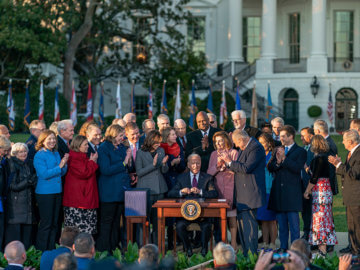
Photo courtesy of @POTUS
Earlier this month, Congress passed and President Joe Biden signed the bipartisan Infrastructure Investment and Jobs Act. This Act represents the largest federal investment in public transit ever, and it covers a variety of priorities including roads, bridges, improved water infrastructure, green investments and unprecedented investments in passenger rail. In addition to the historic investments in the Infrastructure Act, Congress continues negotiations on the Build Back Better Act which currently includes $10 billion in high-speed rail funding through the Passenger Rail Improvement, Modernization, & Emissions Reduction Grant Program.
“President Biden understands the need to build a climate-resilient future, and the infrastructure package passed by Congress builds on California’s unprecedented investments to maintain and modernize the state,” said Governor Gavin Newsom. “This historic infrastructure package stands to accelerate investments in our clean transportation infrastructure, help mitigate some of the worst impacts of climate change and accelerate new projects that will create thousands of jobs.”
Some of the funding pots the Authority may target include:
- Federal-State Partnership for Intercity Passenger Rail, which doesn’t include the Northeast Corridor – $12 billion appropriated (additional $4.125 billion authorized)
- Projects of National and Regional Significance – $5 billion appropriated (additional $5 billion authorized)
- Consolidated Rail Infrastructure and Safety Improvements (CRISI) – $5 billion appropriated (additional $5 billion authorized)
- Railroad-Highway Crossing Elimination – $3 billion appropriated (additional $2.5 billion authorized)
- Rebuilding American Infrastructure with Sustainability and Equity (RAISE) – $7.5 billion appropriated
- Infrastructure for Rebuilding America (INFRA) – $3.2 billion appropriated (additional $4.8 billion authorized)
The action by the federal government caps a year of progress for the high-speed rail program. In the Central Valley, we saw major progress on the project’s 119-miles of active construction. We completed the San Joaquin Viaduct, the first major high-speed structure travelers on State Route 99 encounter when they enter Fresno from the north. We also reached the milestone of over 6,000 construction jobs and partnered with the local Building and Construction Trades Council, Fresno County Economic Development Corporation and Fresno Economic Opportunities Commission to launch a Central Valley Training Center in Selma. This pre-apprenticeship training center provides veterans, at-risk young adults and low-income people from the Central Valley with a comprehensive and innovative look into careers in more than 10 different construction trades.
Beyond the Central Valley, the Authority’s Board of Directors adopted the Final Environmental Impact Report/Environmental Impact Statement (EIR/EIS) for the approximately 80-mile Bakersfield to Palmdale project section this past summer. The action marked the first certification of an environmental document in the Southern California region. This month, the Authority issued the Final EIR/EIS for the Burbank to Los Angeles project section, with that document going before the Authority’s Board of Directors for consideration in January. Next year, we anticipate issuing final environmental documents for the two Northern California project sections, along with additional reviews in Southern California.
Looking forward, we will issue our 2022 Business Plan early next year, which will lay out the path forward for the high-speed rail program for the next two years. We also look forward to continuing our partnerships with the federal government to deliver high-speed rail in California. In August, President Biden showed his support for high-speed rail during a virtual town hall with Fresno Mayor Jerry Dyer. Mayor Dyer told the President that Fresno’s struggles with bad air quality could be improved by clean public transportation, including high-speed rail. The mayor expressed hope that the infrastructure package would provide financial assistance for high-speed rail. President Biden responded, “We kind of had Fresno in mind — I’m not joking — because of the air quality.”
The President, known as “Amtrak Joe” because of his support for rail, didn’t stop there. “We have more money in this area for high-speed rail than all the money we spend on setting up Amtrak. This is a gigantic investment,” he noted. “And you know as well as I do, when people can take a train from point A to point B — conveniently and faster than you can drive your vehicle — they take the train.”
Read more about the Infrastructure Investment and Jobs Act from the White House.
High-Speed Rail Releases Final Environmental Studies to Bring Service to Los Angeles
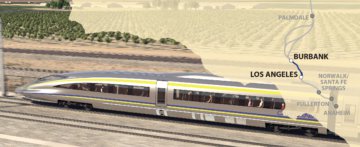
The California High-Speed Rail Authority (Authority) recently released the Final Environmental Impact Report/Environmental Impact Statement (Final EIR/EIS) for the approximately 14-mile Burbank to Los Angeles project section in Southern California, moving the Authority one step closer to approving its fourth environmental document in two years.
The document will be presented to the Authority’s Board of Directors for consideration during a two-day board meeting from January 19 to 20, 2022.
If approved, the Burbank to Los Angeles project section will be the second high-speed rail segment in Southern California to be environmentally cleared, and it will be the first in the Los Angeles Basin. This milestone moves the project section closer to being “shovel ready” for when preconstruction and construction funding become available.
Read more about the Final EIR/EIS at: https://hsr.ca.gov/2021/11/05/news-release-authority-releases-feir-eis-to-bring-hsr-service-to-la/
Authority Highlights Veteran-Owned Small Business

The California High-Speed Rail Authority (Authority) recently released a video profiling the 111th Aerial Photography, a California-certified Small Business and Disabled Veteran Business Enterprise helping map the high-speed rail corridor from Madera to the southwest edge of Fresno.
Pat Belanger, a proud veteran of the 194th Fighter Squadron of the Air National Guard, founded the 111th Aerial Photography in 1994 with his wife, Julie Belanger, who is also a pilot. Since then, they’ve also brought their daughter, Niki Britton, into the family business after she received her pilot’s license.
To learn more about the 111th Aerial Photography, read the latest edition of the Authority’s Small Business Newsletter.
| NORTHERN CALIFORNIA NEWS |
A Conversation with Michelle Bouchard, Caltrain’s Acting Executive Director
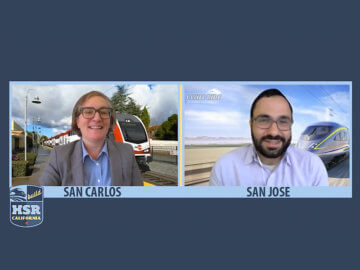
Northern California Regional Director Boris Lipkin talks with Caltrain’s acting Executive Director about progress on electrification of the Caltrain corridor and sharing tracks with high-speed rail.
Caltrain and the California High-Speed Rail Authority have a long-standing partnership to advance improvements through the blended system. The electrification of the rail corridor will increase Caltrain service, reduce emissions by 97% from today’s diesel service, allow passengers to experience new electric trains and pave the way for high-speed rail service.
View their conversation at https://youtu.be/foHqu8DQt7I.
What’s Happening in Northern California
25th Avenue Grade Separation Open to the Public in San Mateo
After much hard work and cooperation, the 25th Avenue Grade Separation Project in San Mateo was officially opened to the public this September. State Senator Josh Becker, Caltrain Board Chair Dev Davis, San Mateo Mayor Eric Rodriguez, Northern California Regional 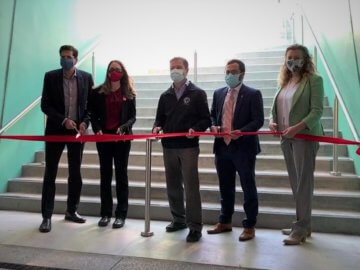 Director Boris Lipkin, San Mateo County Transportation Authority Chair Emily Beach and other officials celebrated with a ribbon-cutting ceremony at the new Hillsdale Caltrain Station.
Director Boris Lipkin, San Mateo County Transportation Authority Chair Emily Beach and other officials celebrated with a ribbon-cutting ceremony at the new Hillsdale Caltrain Station.
The $206 million project, in construction since 2017, raised the tracks at 25th Avenue and created new grade-separated crossings at 28th and 31st avenues. The project connects neighborhoods on opposite sides of the tracks, reduces local traffic congestion and improves safety for motorists, bicyclists and pedestrians.
The California High-Speed Rail Authority (Authority) provided $84 million, leveraging other funds from the San Mateo County Transportation Authority, California Department of Transportation, San Mateo County and the City of San Mateo to fund the project.
The Authority continues to invest in projects that provide regional mobility benefits while paving the way for high-speed rail. The project is an important milestone and a great example of agencies working together to make mutually beneficial infrastructure investments at the state, regional and local levels.
MTC Adopts Plan Bay Area 2050
 In October, the Metropolitan Transportation Commission (MTC) and the Executive Board of the Association of Bay Area Governments (ABAG) adopted Plan Bay Area 2050. The long-term regional plan consists of strategies for economic development and environmental resilience, including investment to bring high-speed rail to the Bay Area.
In October, the Metropolitan Transportation Commission (MTC) and the Executive Board of the Association of Bay Area Governments (ABAG) adopted Plan Bay Area 2050. The long-term regional plan consists of strategies for economic development and environmental resilience, including investment to bring high-speed rail to the Bay Area.
This marks the first time any region has sought to align regional investments in an effort to match state and federal dollars to build California’s high-speed rail system.
Outreach Returns to In-Person Events
After an 18-month pause, the Authority returned to in-person tabling events this summer. The outreach team brought 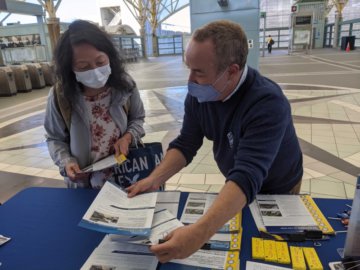 renewed energy to the task of getting the word out about the recirculated environmental document for the San Francisco to San José project section that included a new design option for the Millbrae-SFO station. The Authority’s team answered questions from curious visitors at the Millbrae Farmers Market and handed flyers to commuters who stopped by the table at the Millbrae BART Station.
renewed energy to the task of getting the word out about the recirculated environmental document for the San Francisco to San José project section that included a new design option for the Millbrae-SFO station. The Authority’s team answered questions from curious visitors at the Millbrae Farmers Market and handed flyers to commuters who stopped by the table at the Millbrae BART Station.
Activities continued into the fall with tables at various outdoor festivals, including Viva Calle in San José, the Los Banos Downtown Street Faire and Phoenix Day in San Francisco. By November, the team returned to Farmers Markets in Burlingame, Mountain View and Redwood City. Each event was an opportunity for people to learn more about the program and ask questions.
Regional Transit Collaboration
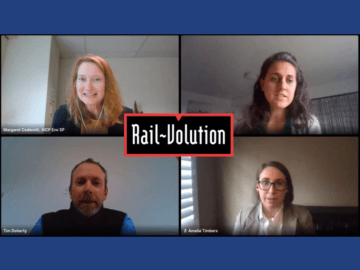 At the virtual Rail~Volution 2021 conference in October, the Authority’s Director of Planning and Sustainability Meg Cederoth moderated a climate resiliency discussion that explored how Northern California transportation agencies work together on sustainability issues. Experts from SamTrans, SFMTA and BART joined Cederoth to discuss lessons learned over the past decade and examined how transit agencies are fighting climate change with programs that also improve the quality of life for everyone in the Bay Area. For more information about the Authority’s sustainability work, download the 2021 Sustainability Report.
At the virtual Rail~Volution 2021 conference in October, the Authority’s Director of Planning and Sustainability Meg Cederoth moderated a climate resiliency discussion that explored how Northern California transportation agencies work together on sustainability issues. Experts from SamTrans, SFMTA and BART joined Cederoth to discuss lessons learned over the past decade and examined how transit agencies are fighting climate change with programs that also improve the quality of life for everyone in the Bay Area. For more information about the Authority’s sustainability work, download the 2021 Sustainability Report.
Salesforce Transit Center Transforms Downtown San Francisco
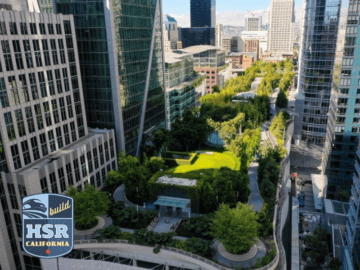 San Francisco is known for transportation icons such as the Golden Gate Bridge and cable cars. Today, we can add another monument to the list of transit icons for the city by the Bay – the Salesforce Transit Center.
San Francisco is known for transportation icons such as the Golden Gate Bridge and cable cars. Today, we can add another monument to the list of transit icons for the city by the Bay – the Salesforce Transit Center.
In cooperation with the Transbay Joint Powers Authority (TJPA), the California High-Speed Rail Authority held a virtual Town Hall from the celebrated transit center in September. The event featured a pre-recorded walking tour and a live Q&A from the rooftop park.
Northern California Regional Director Boris Lipkin began the tour by introducing TJPA Interim Executive Director Nila Gonzales, who provided an overview of the Transbay Program. A behind-the-scenes walking tour came next, highlighting the grand hall, bus deck and the lower-level train box.
After the tour, Public Information Officer Kyle Simerly moderated a Q&A session with Lipkin from the rooftop park amphitheater. The forum addressed dozens of questions and comments submitted via Zoom, Facebook and YouTube.
You can check out a video of the walking tour or the full-length Town Hall video on our YouTube channel.
Flying is a Family Affair for Former Military Pilot
As the sun rises on San Martin Airport, the sky is clear and the air is crisp – picture perfect conditions for flying. Pat Belanger is ready to get up in the air and photograph the latest progress on California’s high-speed rail system.
 Pat is a proud veteran who needed to keep busy after retiring from the 194th Fighter Squadron of the Air National Guard. Since his wife Julie was also a pilot, he suggested they try aerial photography together. She didn’t think it was a good idea, but once Julie found herself behind the lens, everything fell into place.
Pat is a proud veteran who needed to keep busy after retiring from the 194th Fighter Squadron of the Air National Guard. Since his wife Julie was also a pilot, he suggested they try aerial photography together. She didn’t think it was a good idea, but once Julie found herself behind the lens, everything fell into place.
Pat and Julie started The 111th Aerial Photography in 1994, filming residential real estate from the family’s Cessna 182 Skylane. Since then, the California-certified Small Business and Disabled Veteran Business Enterprise added helicopters, drones and specialized camera equipment to get the perfect shot. They also expanded services to include commercial real estate photography, mapping and aerial surveys. In 2017, the Belanger’s daughter, Niki Britton, joined the crew after receiving her pilot’s license. Today, Pat manages the aircraft while Julie and Niki focus on shooting photos and video.
Capturing compelling photos of infrastructure projects is not as easy as it may appear. The 111th relies on decades of combined experience to produce awe-inspiring visuals. They have photographed Google headquarters, the Chase Center and the construction of Levi’s Stadium. Recently, the 111th documented the devastating impact the drought is having on water supplies of the Santa Clara County reservoirs. “What we’ve been able to do for our clients is give them the big picture,” said Julie.
In 2015, The 111th began mapping the high-speed rail corridor from Madera to the southwest edge of Fresno. Pat shared how the images are processed using a geographic information system (GIS). “We shoot monthly nadir photography, which is straight down, every 400 feet.” They tag the photos with metadata, including latitude and longitude coordinates—the packaged files contain the information needed for internet-based maps, like Google Earth. “We shoot the same exact locations,” explained Julie, “You can drill down through the layers to see the changes every month on that particular location.”
Aerial photography has kept the Belangers busy. With Pat’s passion for flying and Julie’s eye, they have created an enduring family business that captures spectacular views of the world from above.
Read more about other small businesses in the November 2021 Small Business Newsletter.
Frequently Asked Questions
Northern California high-speed rail staff respond to many inquiries from residents, local agencies, neighborhood groups and other stakeholders. Below are answers to some of the more common questions about the program.
Why build high-speed rail in Northern California?
An environmentally clean, fast and safe high-speed rail system will provide modern transportation for the millions of Northern California residents, put people to work building the system, spur economic growth and help achieve our state’s ambitious climate goals. The system will have stations in San Francisco, Millbrae, San José and Gilroy that will connect with BART, Caltrain, Amtrak, ACE and other regional transit options.
What is a blended system?
In 2012, the Authority reached a landmark agreement with Caltrain and regional partners to develop a blended system along the San Francisco to San José corridor. “Blended” means Caltrain and high-speed rail trains will share tracks within the existing Caltrain corridor. As part of the agreement, Caltrain is electrifying the corridor with funding from the Authority through Proposition 1A. This approach minimizes impacts on surrounding communities, reduces project cost, improves safety and expedites implementation of high-speed rail.
How does the design for high-speed rail ensure that wildlife can cross from one side of the tracks to the other?
Where tracks are elevated, most animals can cross underneath. Viaducts have sufficient space between columns and enough height to allow for easy access and movement. Where the tracks are on the ground or an embankment, wildlife can cross underneath through crossings designed to meet specific species’ needs. The crossings range in size to accommodate animal species — from amphibians that feel comfortable in a relatively small opening to much larger animals such as deer that require more space to pass through. Go to our YouTube channel to learn more about wildlife crossings.
Have any questions for the NorCal team? Please submit them to us at northern.calfornia@hsr.ca.gov.
Upcoming Events
Here are a few upcoming events in Northern California that you won’t want to miss!
ARTBA’s 11th Annual Student Transportation Industry Video Contest
Submission Deadline:
December 3, 2021
The American Road & Transportation Builders Association (ARBTA) is hosting a student video contest. Students of all ages can get creative and show off their knowledge of and interest in transportation. Click here for more information.
Roaring Camp Railroads Holiday Train Rides
November 26 through December 23, 2021
Enjoy holiday festivities aboard the Redwood Forest Steam Train or the Santa Cruz Holiday Lights Train. Click here for more information.
| SOUTHERN CALIFORNIA NEWS |
LaDonna’s Corner
In the latest LaDonna’s Corner, Southern California Regional Director LaDonna DiCamillo provides an overview of progress in the Southern California region in 2021 and a look ahead to anticipated progress in 2022.
Earlier this month, the Burbank to Los Angeles Project Section Final Environmental Impact Statement/Environmental Impact Report (EIR/EIS) became the second project section in Southern California to be published. In August, the Board agreed to certify the Bakersfield to Palmdale Final EIR/EIS, the first project section document published, clearing the way to add 80 miles to the 199 miles already environmentally cleared on the high-speed rail project, connecting the Central Valley to Southern California’s Antelope Valley in Los Angeles County.
In early 2022, the Palmdale to Burbank Project Section Draft EIR/EIS is anticipated to be released, accompanied by public meetings, and the opportunity for public comment on the document. Check the Authority’s website for information on the four project sections in the Southern California region and how to provide public comment when the Palmdale to Burbank Draft EIR/EIS is released in 2022.
View LaDonna’s video on our YouTube page.
Burbank to Los Angeles – A Look Ahead
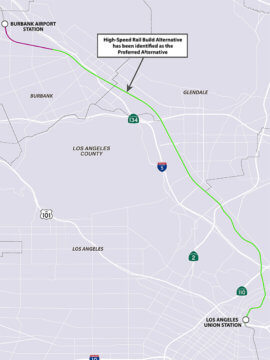
The Burbank to Los Angeles project section Final Environmental Impact Report and Impact Statement (Final EIR/EIS) was released to the public this November 5 and will be presented to the California High-Speed Rail Authority’s (Authority) Board of Directors for consideration during a two-day board meeting on January 19-20, 2022. The approximately 14-mile Project Section will connect two key multi-modal transportation hubs, the Hollywood Burbank Airport and Los Angeles Union Station (LAUS).
As part of the Southern California bookend investments, the Authority has committed $441 million to the Link US project to increase the regional and intercity rail service capacity of LAUS, accommodating the planned high-speed rail system in Southern California. The Hollywood Burbank Airport Station will be within walking distance of the Hollywood Burbank Airport Replacement Terminal, providing the first air to high-speed rail connection in the United States. Throughout the design and construction process, and to ensure the project complies with all regulations and requirements, the Authority will work closely with the Federal Aviation Administration and the Burbank-Glendale-Pasadena Airport Authority.
If the Final EIR/EIS is approved, the Burbank to Los Angeles project section will be the second environmentally cleared document for the Southern California Region moving the project section closer to being “shovel ready” for when preconstruction and construction funding becomes available.
“This is an exciting time for the Southern California Region as we continue outreach with agency partners and stakeholders in our region,” said Southern California Regional Director LaDonna DiCamillo. “The Authority recognizes the importance of these collaborations and we are committed to investing in partnerships with local and regional agencies while stimulating job growth, increasing mobility and improving air quality.”
The Southern California Region has four project sections including Bakersfield to Palmdale, Palmdale to Burbank, Burbank to Los Angeles and Los Angeles to Anaheim. The Bakersfield to Palmdale project section was environmentally cleared this summer.
Brightline West Moves Forward with Rancho Cucamonga Station Plans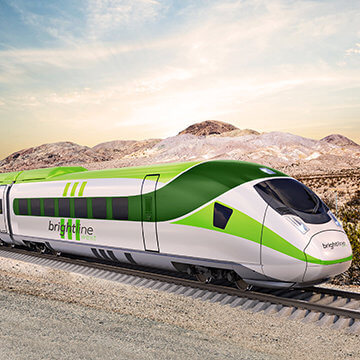
Brightline West, a private provider of intercity rail in the United States, is planning to build a high-speed rail line to connect Las Vegas, Nevada and Victorville, California with plans to connect Rancho Cucamonga and Palmdale. Connecting California high-speed rail and Brightline West systems in Palmdale via the high-desert corridor from Victorville would generate significant benefits for both rail systems, including higher ridership and the possibility of bringing high-speed rail benefits to Southern California sooner.
In October 2021, the finalization of a memorandum of Understanding (MOU) with Brightline West, the California State Transportation Agency (CalSTA), the California Department of Transportation (Caltrans), and the California High-Speed Rail Authority was announced. The MOU was signed with the intent to evaluate opportunities to extend the high-speed rail system, share information to evaluate interoperability and identify joint purchasing opportunities for materials and trainsets.
The MOU sets out plans for Brightline West to connect its planned Victor Valley station and a newly planned station in Rancho Cucamonga. The Brightline West system will connect to the Authority’s statewide system through the Palmdale Station which will connect the Central Valley to Southern California. Brightline’s station in Rancho Cucamonga will provide a connection from Victor Valley to Los Angeles Union Station through the Metrolink route from Rancho Cucamonga, providing convenient access in about an hour or less to many cities in the Greater Los Angeles area, including to Union Station in downtown Los Angeles.
“In entering into this MOU with Brightline West, CalSTA, Caltrans and the California High-Speed Rail Authority are setting the course for high-speed trains to connect Southern California and Las Vegas,” said CalSTA Secretary David S. Kim. “This is an important step in bringing major benefits to the state, including reduced congestion and greenhouse gas emissions on the Interstate 15 corridor and increased connectivity with rail and transit throughout Southern California as well as future connections with the state’s high-speed rail system.”
Read more information about the MOU signing.
Southern California Manufacturer is Part of the Fabric of High-Speed Rail
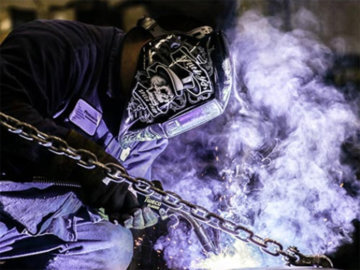
Photo Courtesy of Brian Pendarvis
When the California Rail Builders came calling, Pendarvis Manufacturing was ready. Based in Anaheim, the Disabled Veteran Business Enterprise was tasked with designing and manufacturing lap joints for high-speed rail viaducts in the Wasco area. The friction free joints support the structures, allow for the movement of trains and provide safety if an earthquake hits.
Before owner Brian Pendarvis joined the company, he served in the U.S. Army as a military intelligence specialist in the infantry division. Working alongside of his three brothers, he purchased the firm from his dad in 2015. He acknowledged what he learned in the military still motivates him today. “The dedication that it takes to be a soldier continues to inspire me to work hard and bring that same commitment to operations at Pendarvis Manufacturing,” said Pendarvis.
The company has grown under his leadership. More than 25 people work out of 15,000 square-foot manufacturing facility and help bring in almost $5 million a year in annual sales. Pendarvis noted, “I couldn’t do it without all the dedicated people who work for us.”
Read more about Pendarvis Manufacturing and other small businesses in the November 2021 Small Business Newsletter.
 Frequently Asked Questions
Frequently Asked Questions
Southern California high-speed rail staff respond to many inquiries from residents, local agencies, neighborhood groups and other stakeholders. Below are answers to some of the more common questions about the program.
How will High-speed rail reduce greenhouse gas (GHG) emissions in Southern California?
At this very moment, at-grade rail crossings throughout northern and southern California are being upgraded or eliminated. This reduces traffic congestion, improves safety and cuts GHG emissions from idling vehicles. A single at-grade rail crossing can cause up to 45 days of stopped traffic per year, which results in about 1,800 tons of GHG emissions annually. Most notably, plans are proceeding to grade separate Rosecrans/Marquardt in Santa Fe Springs, a joint project with the California High-Speed Rail Authority (Authority), the Los Angeles County Metropolitan Transportation Authority (Metro) and Caltrans. The Authority has allocated $76.7 million from Proposition 1A bond funds, matched by other local funding sources to complete the $155.3 million project. Visit hsr.ca.gov/2018/05/02/high-speed-rail-authority-announces-agreement-with-l-a-metro-for-major-socal-grade-separation-project for more information.
Is the high-speed rail system going from Southern California to Las Vegas?
Brightline West is the private high-speed rail company constructing a high-speed rail system from Southern California to their station in Las Vegas. The system will connect in Southern California from Victor Valley to their Rancho Cucamonga station in the newly announced HART District, a full-service transit station building that will include the existing Metrolink platforms and a planned underground tunnel to Ontario International Airport. Through its connectivity with Metrolink, guests will have fast and convenient access in about an hour or less to many cities in the Greater Los Angeles area, including to Union Station in downtown Los Angeles and other destinations throughout Southern California. Visit brightlinewestconstruction.com/brightline-west-on-track-to-rancho-cucamonga for more information.
Have any questions for the SoCal team? Please submit them to us at southern.calfornia@hsr.ca.gov.
Quarterly Newsletter Archive
- Spring 2023 All Aboard Newsletter
- Winter 2023 Quarterly Newsletter
- Fall 2022 Quarterly Newsletter
- Summer 2022 Quarterly Newsletter
- Spring 2022 Quarterly Newsletter
- Winter 2022 Quarterly Newsletter
- Fall 2021 Quarterly Newsletter
- Summer 2021 Quarterly Newsletter
- Regional Newsletter - May 2021
- Regional Newsletter - February 2021
- Regional Newsletter - November 2020
- Regional Newsletter - August 2020
- Regional Newsletter - June 2020
- Regional Newsletter - February 2020
- Regional Newsletter - November 2019
- Regional Newsletter - August 2019
The California High-Speed Rail Authority makes every effort to ensure the website and its contents meet mandated ADA requirements as per the California State mandated Web Content Accessibility Guidelines 2.0 Level AA standard. If you are looking for a particular document not located on the California High-Speed Rail Authority website, you may make a request for the document under the Public Records Act through the Public Records Act page. If you have any questions about the website or its contents, please contact the Authority at info@hsr.ca.gov.


